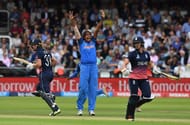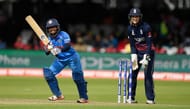The Indian women's cricket team, struggling through many hurdles - before and after cricket, found their way into millions of hearts with their phenomenal run at the ICC Women's Cricket World Cup 2017. Unfortunately, they were left disappointed at the last hurdle with a 9-run loss to England.
The next morning, the loss had still not sunk in. It was surprising, how, a team that was relatively unknown to most until the start of the 2017 World Cup, managed to force their way into billions of hearts with only nine matches.
“Women’s cricket in India metamorphosed during the World Cup. In 2005, the girls played Australia in the final, but the attention they received was not as much. I have heard about the stories of the then team, it was packed with some equally brilliant individual performances,” NCA accredited cricket physiotherapist, Mrs Anuja Dalvi Pandit recalled in an exclusive interview with Sportskeeda.
She has a degree in Master of Musculoskeletal and Sports Physiotherapy from the University of South Australia.
“However, with furtherance in technology, the world has got closer through digital media, which is why we got to witness each moment of the 2017 edition. What underlines the success of the team is that we didn’t just watch the games but also enjoyed every bit of the show. The girls didn’t conquer the coveted silverware but conquered a billion hearts,” Pandit continued.
Pandit has worked with the national team on multiple occasions through NCA and the BCCI. She has been a part of women’s cricket since 2009 when she joined the Mumbai Cricket Association as a physiotherapist for the senior team.
Most recently, Pandit was also part of a fitness camp with the girls before they left for the quadrangular series in South Africa.
“The girls got great exposure on the tour to South Africa earlier this year. Performances like the world record partnership between Punam Raut and Deepti Sharma, and returning home with the tournament trophy, boosted the team’s morale and that helped their case in England,” she says.
Similar fitness regimens for male and female cricketers
For years, it has been speculated that men are fitter than women. The two genders have different levels of hormones, different amount of fat and muscles.
How, then, are women cricketers as athletic as their male counterparts?
Pandit explains that the fitness regime for both men and women’s teams are the same, and playing cricket has not much to do with the build of the body.
“Women’s and men’s cricket both follow similar fitness regimes, although there are obvious physiological issues to consider. Cricket fitness relies heavily on stability and balance, on hand-eye co-ordination and sports specific strength. You don’t have to be a body builder to be a good cricketer.”
“But to an extent, strength training also plays a significant role since the pace of the game is increasing with each passing day. There are injury prevention strategies that the physiotherapists use to prevent overuse injuries,” Pandit elucidates.
Among the current crop of cricketers, she names Harmanpreet Kaur, Punam Raut, Deepti Sharma and Smriti Mandhana as some of the fittest in the team.
“Punam Raut, Harmanpreet Kaur, Deepti Sharma & Smriti Mandhana are some of the fitter players in this current team and it is obvious on the screen. As I aforementioned, you need not be too strong physically but should have a combination of balance, stability and coordination. You can observe the cricket fitness with Mithali’s elegant strokes.”
“Tracy Fernandez, a dear friend and the physiotherapist with the team has done a wonderful job with Mithali’s fitness and prehab.”
On Jhulan Goswami’s fitness

Jhulan Goswami’s exemplary fitness at the age of 34 is remarkable. The highest wicket-taker in ODI cricket, she registered a dream bowling spell in what was possibly her last appearance in World Cups.
In her 10 overs, the Bengal tigress picked 3 wickets and gave away only 23 runs. The Chakdaha Express, as Jhulan is fondly called, was the fastest pacewoman in the world in 2007.
In the World Cup 2017, she was seen bowling at an astounding speed of 120kmph, which for a woman is equivalent to a man’s 140kmph. According to Pandit, years of maintaining strict fitness regime has helped the fast-bowler use her prowess till date.
“Good recovery techniques and body weight training in various forms is the base for players performing their best at later stages in their career.
Fast bowlers were always required to have a superior level of fitness in cricket. This is achieved with sports specific supervised strength and conditioning programs. Jhulan Goswami over all these years has put in a lot of effort to maintain her fitness, and you can see the results.”
And while the common perception about women’s cricket is lack of adequate facilities, Pandit acknowledged the system for having some of the best physiotherapists and trainers for the women.
“We have some of the best physios and strength and conditioning professionals for the players as per their individual needs. Not only is the support staff that travels with the team world class, but the professionals at the National Cricket Academy also play a key role in the girls’ injury management and fitness.”
Punam Raut played with boys, Harmanpreet Kaur loves football

Punam Raut, who was the top-scorer for India with 86 runs in the World Cup final, finished the tournament as the highest scorer for India with 381 runs, behind the captain Mithali Raj, who top scored with 409 runs.
After making her debut in 2009, Raut was dropped from the team in 2012 due to inconsistent performances. But the eager beaver improved her performances in the domestic circuit, and forced herself back into the team in 2013 when was selected for the World Cup squad.
However, Raut couldn’t make much of the World Cup opportunity and was dropped from the team one more time. From 2013 until the South Africa series earlier this, she featured in only 13 ODIs. Much to your surprise, the 27-year-old, who was phenomenal during the World Cup, was not even selected for the World Cup qualifiers due to poor form.
Pandit, who has worked closely with Raut in the Mumbai ranks, recalls how hard the opener worked in the domestic circuit to cement her place in the national squad for the quadrennial event.
“Carrying the legacy of Mumbai’s Khadoos Cricket, Punam Raut made a dream comeback into the national team after performing exceptionally well in the domestic circuit where she plays for Indian Railways. She has worked very hard on her fitness since the past few months and has seen an exceptional improvement in her strength,” Pandit tells us.
“This has also helped her stay away from injuries. She has become quite a sensation in Mumbai cricket. Punam, since the beginning of her career, has always played with boys to up her performance,” shares the Mumbai based physiotherapist.
India’s T20 captain Harmanpreet Kaur sent fans and fellow cricketers into a tizzy when she scored an unbeaten 171 against the best bowling attack, Australia, in the semi-final. And that blinder unfolded when Kaur was suffering from cramps in her legs. With due respect to the individuality of women cricketers, Pandit feels that Kaur possesses the same talent as Indian captain Virat Kohli.
“Harman or Harry as people lovingly call her is an extremely strong and charming character. You can call her Virat Kohli of Women’s cricket. She has always been a strong bat and a pleasure to watch,” Pandit heaps praises on the 28-year-old, who, post her heroics, has been offered the post of DSP in Punjab police.
The turning point in Kaur’s career, Pandit feels, has been her association with the Big Bash League. Kaur and Smriti Mandhana are the only two Indian cricketers to play in the extravagant Australian tournament.
“In recent years, Harry has earned herself great respect, not only in India but also in Australia where she plays for the Sydney Thunders in Big Bash. The experience of playing Down Under has helped her churn out some brilliant performances. Australians surely bring the best out of Harry,” she says.
Pandit also revealed a less known fun fact about Kaur. Apparently, the middle order batswoman loves football and also leads the side when they play soccer in between breaks during nets sessions.
“If not cricketer, Harry would have been a footballer for sure. She loves the game and always leads her team in footy during breaks in practice or fitness sessions.”
Women’s Cricket needs to grow at the grassroots level
Soon after the 15 heroes made it to the finals of theWorld Cup, the Indian cricket board announced prospects of an IPL-like tournament for them. But only hours after that announcement, the prospect was called ‘far-fetched’ due to the board’s financial constraints. Whether or not an IPL for women is on the cards, Pandit feels that there are other more important things to address for the growth of women’s cricket. While popularity of the sport is one thing, making it professional is also important, and women cricketers should no longer have to juggle for employment.
While women’s cricket has grown substantially at the global level, the growth at the grassroots level is still minimal.
“In the last few years of my association with women’s cricket, I have seen many girls giving up on their dream to follow the sport due to limited financial resources. There are not many jobs in women’s cricket as compared to men’s. The need of the hour is not IPL but instead local and state level tournaments need to be promoted, which in turn can create more job opportunities for the girls.”
After India’s meteoric rise at the international level, they have finally come out of the shadow of their male counterparts. Pandit reiterates that both men’s and women’s cricket should be seen differently, and enjoyed in their own ways.
“The team’s performance has motivated hundreds of girls to take up cricket as a sport and follow it professionally. We shouldn’t discriminate between men’s and women’s cricket, both are different and both are enjoyable. At the end, it is the game of cricket that wins,” Pandit concludes.
Looking for fast live cricket scores? Download CricRocket and get fast score updates, top-notch commentary in-depth match stats & much more! 🚀☄️
